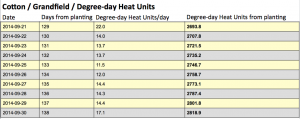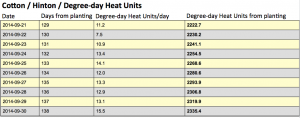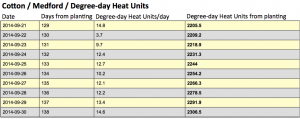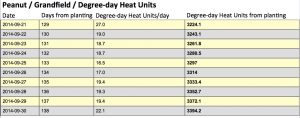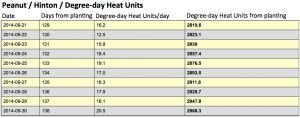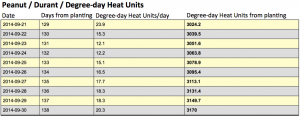Fall really brings out the differences in crop heat units. It’s a time that highlights the differences in each days heat units and their accumulation.
Growers are carefully monitoring cotton and peanuts in Oklahoma to prepare for harvest this fall and early winter. One of the weather-based tools available to farmers are degree-day heat unit calculators. This tool uses daily air temperature minimums and maximums to calculate the heat units crops receive to drive growth. Accumulated degree-day heat units over the growing season provide an estimate of crop maturity.
The Oklahoma Mesonet has Degree-Day Heat Unit Calculators for alfalfa, corn, cotton, grass hay, peanut, sorghum, soybean, and wheat. Users can go back to 2004 to compare heat units from previous years to each other or the current season. Growers can enter their closest Mesonet site and crop planting date to calculate a custom degree-day heat units for their crop.
For cotton, growers need between 2,200 and 2,600 degree-day heat units, depending on type and variety, based on a 60 degree F minimum and 100 degree F maximum. For peanuts, growers would like to have 2,400 to 2,700 degree-day heat units, depending on type and variety, based on a 55 degree F minimum and 95 degree F maximum.
What can we learn from some 2014 cotton and peanut heat units for some select locations in Oklahoma?
Grandfield is consistently one of the hottest spots in the state and nearby farmers raise both cotton and peanuts. Hinton is a little farther north, farmers near there also raise both cotton and peanuts. Medford is a northern Oklahoma cotton growing area. Durant, in southern Oklahoma, has a long history of peanut production.
The following degree-day heat units for cotton and peanut were based on planting dates of May 15 for both crops. These are the default planting dates used by the Oklahoma Mesonet Degree-day Heat Unit Calculator.
As of September 30, 2014, the COTTON Degree-day Heat Units for:
- Grandfield was 2,819 with a peak day of 29 on Aug 21 & Sep 1
- Hinton was 2,335 with a peak day of 28 on Aug 22
- Medford was 2,306 with a peak day of 29 on Aug 21 & 22
Grandfield had 513 more cotton heat units than Medford as of September 30th. That’s 22% more heat units, and yet their peak heat units for a single day this growing season were the same. That highlights how Grandfield has had a higher number of warmer, hotter days than Medford.
[Full site: mesonet.org/Agriculture/Degree-day Heat Unit Calculator]
As of September 30, 2014, the PEANUT Degree-day Heat Units for:
- Grandfield was 3,394 with a peak day of 31 on Jun 17, 18, 29, 30, Jul 26, 27, Aug 6, 9, 20, 21, 22, Sept 1, 2, 3
- Hinton was 2,968 with a peak day of 30 on Aug 16, 20, 21, 22, Sept 1
- Durant was 3,170 with a peak day of 31 on on Jun 29, Jul 27, Aug 22, Sept 10
For Peanut, Grandfield and Durant both had a 31 heat unit peak for a single day. The difference was Grandfield had 31 heat units on 14 days, while at Durant only 4 days had a peak of 31. Grandfield had 224 more heat units through September 30 for the 2014 growing season. That’s 7% more heat units than Durant. Grandfield had 426 more heat units, than cooler Hinton. That was 14% more heat units at Grandfield than Hinton for peanuts through September 30th.
[Full site: mesonet.org/Agriculture/Degree-day Heat Unit Calculator]
Even though cotton and peanut degree-day heat units both cover a 40 degree spread, the lower base threshold of 55 degrees F for peanut allows for a higher accumulation. For peanut at Grandfield, there were 575 more degree-day heat units than for cotton as of September 30th. We also see a slight increase in the peak day heat units from 29 for cotton to 31 for peanut and a much higher number of peak days, 14 for peanut versus 2 for cotton. At Hinton there were 633 more degree day heat units for peanut than cotton, a slightly wider spread in heat units over the growing season than at Grandfield.
Degree-day heat units really put numbers to the growing season and allows growers to monitor crop maturity from a measured perspective day by day.

